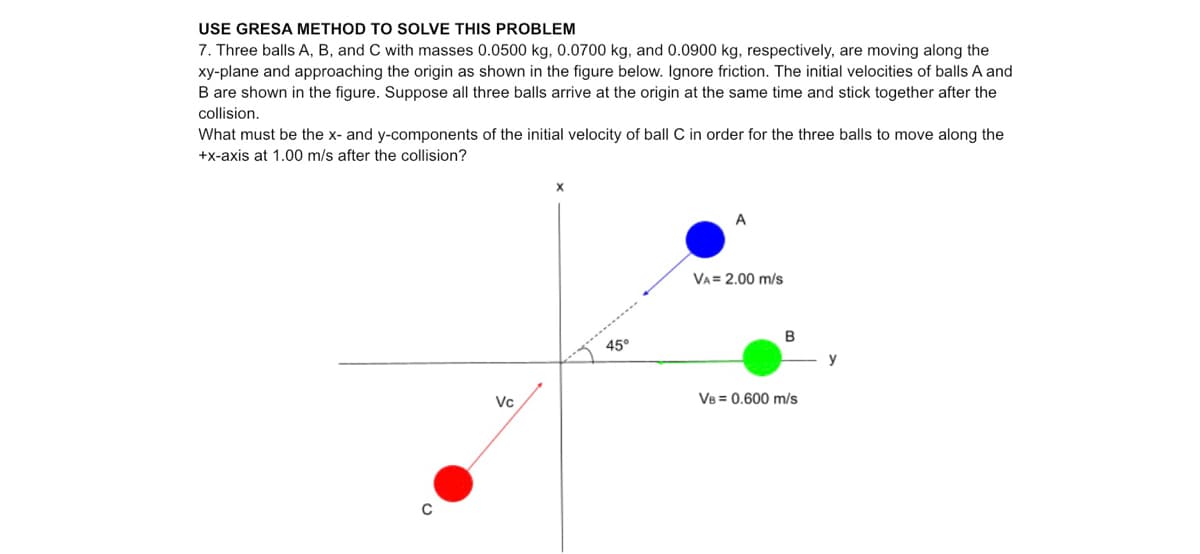USE GRESA METHOD TO SOLVE THIS PROBLEM 7. Three balls A, B, and C with masses 0.0500 kg, 0.0700 kg, and 0.0900 kg, respectively, are moving along the xy-plane and approaching the origin as shown in the figure below. Ignore friction. The initial velocities of balls A and B are shown in the figure. Suppose all three balls arrive at the origin at the same time and stick together after the collision. What must be the x- and y-components of the initial velocity of ball C in order for the three balls to move along the +x-axis at 1.00 m/s after the collision? Vc 45° A VA= 2.00 m/s B VB = 0.600 m/s y
USE GRESA METHOD TO SOLVE THIS PROBLEM 7. Three balls A, B, and C with masses 0.0500 kg, 0.0700 kg, and 0.0900 kg, respectively, are moving along the xy-plane and approaching the origin as shown in the figure below. Ignore friction. The initial velocities of balls A and B are shown in the figure. Suppose all three balls arrive at the origin at the same time and stick together after the collision. What must be the x- and y-components of the initial velocity of ball C in order for the three balls to move along the +x-axis at 1.00 m/s after the collision? Vc 45° A VA= 2.00 m/s B VB = 0.600 m/s y
Glencoe Physics: Principles and Problems, Student Edition
1st Edition
ISBN:9780078807213
Author:Paul W. Zitzewitz
Publisher:Paul W. Zitzewitz
Chapter9: Momentum And Its Conservation
Section: Chapter Questions
Problem 50A
Related questions
Topic Video
Question
100%
USE GRESA METHOD FOR THE SOLUTION
7. Three balls A, B, and C with masses 0.0500 kg, 0.0700 kg, and 0.0900 kg, respectively, are moving along the xy-plane and approaching the origin as shown in the figure below. Ignore friction. The initial velocities of balls A and B are shown in the figure. Suppose all three balls arrive at the origin at the same time and stick together after the collision.
What must be the x- and y-components of the initial velocity of ball C in order for the three balls to move along the +x-axis at 1.00 m/s after the collision?

Transcribed Image Text:USE GRESA METHOD TO SOLVE THIS PROBLEM
7. Three balls A, B, and C with masses 0.0500 kg, 0.0700 kg, and 0.0900 kg, respectively, are moving along the
xy-plane and approaching the origin as shown in the figure below. Ignore friction. The initial velocities of balls A and
B are shown in the figure. Suppose all three balls arrive at the origin at the same time and stick together after the
collision.
What must be the x- and y-components of the initial velocity of ball C in order for the three balls to move along the
+x-axis at 1.00 m/s after the collision?
Vc
45°
A
VA= 2.00 m/s
B
VB = 0.600 m/s
y
Expert Solution
This question has been solved!
Explore an expertly crafted, step-by-step solution for a thorough understanding of key concepts.
Step by step
Solved in 3 steps with 2 images

Knowledge Booster
Learn more about
Need a deep-dive on the concept behind this application? Look no further. Learn more about this topic, physics and related others by exploring similar questions and additional content below.Recommended textbooks for you

Glencoe Physics: Principles and Problems, Student…
Physics
ISBN:
9780078807213
Author:
Paul W. Zitzewitz
Publisher:
Glencoe/McGraw-Hill

College Physics
Physics
ISBN:
9781305952300
Author:
Raymond A. Serway, Chris Vuille
Publisher:
Cengage Learning

University Physics Volume 1
Physics
ISBN:
9781938168277
Author:
William Moebs, Samuel J. Ling, Jeff Sanny
Publisher:
OpenStax - Rice University

Glencoe Physics: Principles and Problems, Student…
Physics
ISBN:
9780078807213
Author:
Paul W. Zitzewitz
Publisher:
Glencoe/McGraw-Hill

College Physics
Physics
ISBN:
9781305952300
Author:
Raymond A. Serway, Chris Vuille
Publisher:
Cengage Learning

University Physics Volume 1
Physics
ISBN:
9781938168277
Author:
William Moebs, Samuel J. Ling, Jeff Sanny
Publisher:
OpenStax - Rice University

Principles of Physics: A Calculus-Based Text
Physics
ISBN:
9781133104261
Author:
Raymond A. Serway, John W. Jewett
Publisher:
Cengage Learning


Physics for Scientists and Engineers: Foundations…
Physics
ISBN:
9781133939146
Author:
Katz, Debora M.
Publisher:
Cengage Learning